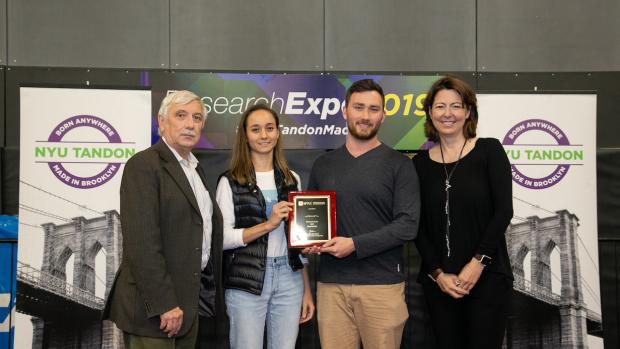From robots to virtual reality to gene therapy — the NYU Tandon Research Expo had it all

Winners of the first place prize for the best exhibit: Graduate students Nicole Schnabel and Adlai Katzenberg for their project, "Hydrogel-Photocatalyst Composite Flow Reactor for Removal of Trace Contaminants from Wastewater"
When the doors to the annual NYU Tandon Research Expo opened on May 3, attendees were greeted with a veritable tech playground, with dozens of exhibits and hands-on activities. Student teams took to the stage to present fast-paced summaries of major projects — from building a robotic vehicle capable of mining regolith from the surface of Mars to creating a self-contained urban farm.
If you wanted to see robots 3D-printing concrete, learn how gene therapy can accelerate wound healing, and discover how wearable technologies can support mental health, you were in the right place. Visitors could also:
- See how AI is playing a role as NYU collects and analyzes the number-one complaint of New Yorkers: noise
- Play an immersive virtual reality game and see how developers collect data on head and hand movement to enhance gameplay
- Test a new tracking tool that allows New Yorkers to avoid predatory landlords before signing leases
- Examine how smart transportation technology will someday predict traffic jams and parking opportunities in NYC
- Track eye movement during a set of tasks to determine emotional responses to different architecture
- See a new in-home exercise system for patients with risks for breast-cancer-related lymphedema
- Learn about a breakthrough study to help secure the quantum computers of the future
- Discover how fiber optics are being used in the wind turbine industry
- Advocate for the responsible use of your data
Four teams were honored for their technical innovation and social impact
First Place
First-place winner was “Hydrogel-Photocatalyst Composite Flow Reactor for Removal of Trace Contaminants from Wastewater,” a project undertaken with the understanding that meeting the global demand for potable water is one of society’s most pressing challenges.
Second Place
In second place was “Brooklyn BioScience,” a startup devoted to the development of a low-cost and ecologically friendly enzyme for the remediation and detoxification of a class of common pesticides. (The project has already proven to be of great interest to vintners and other growers of high-value crops.)
Third Place
In third place was “Soft Robot Proprioception via Deep Vision-based Sensing,” whose creators explained that soft robots are those fashioned from highly compliant materials — in this case with added state-of-the-art artificial intelligence (in effect, "eyes and brains") that allow for positional awareness. (Put in human terms, the fact that we can sense one of our legs is raised at an angle, even when our eyes are closed, is an example of proprioception.)
Vertically Integrated Projects (VIP)
Of the teams presenting on the main stage, each a member of Tandon’s Vertically Integrated Projects (VIP) initiative (which allows students to take part in important multidisciplinary projects over the course of several semesters), the favorite was deemed to be “3D Printed Biomedical Devices.” The creators explained that orthotic devices can help those with cerebral palsy (CP) and other movement disorders, tackle everyday activities and gain independence, but custom orthotics are often clunky, expensive, and — in the case of children — quickly outgrown. In response, they designed low-cost, highly adaptable, 3D-printed devices for young patients — making them in various custom colors as an added bonus.




